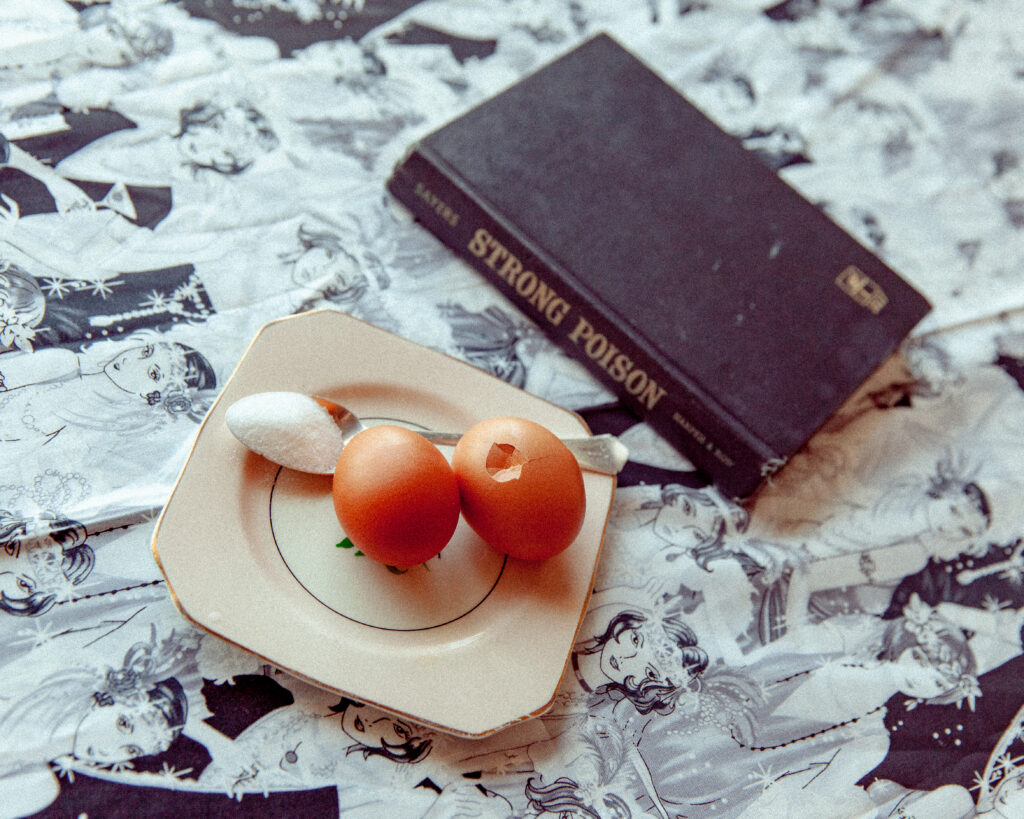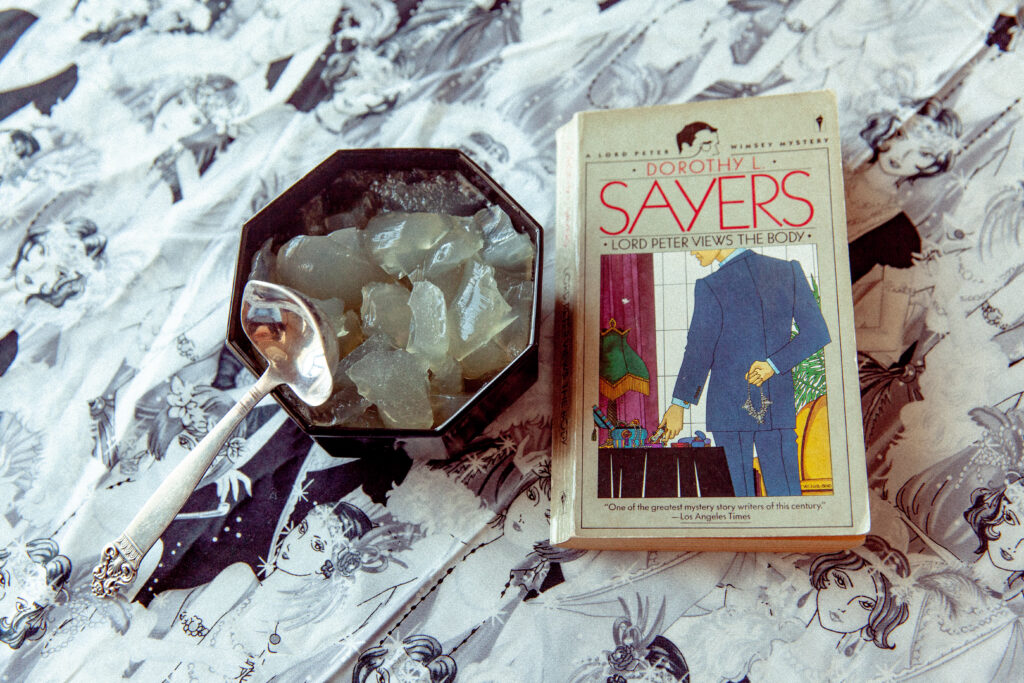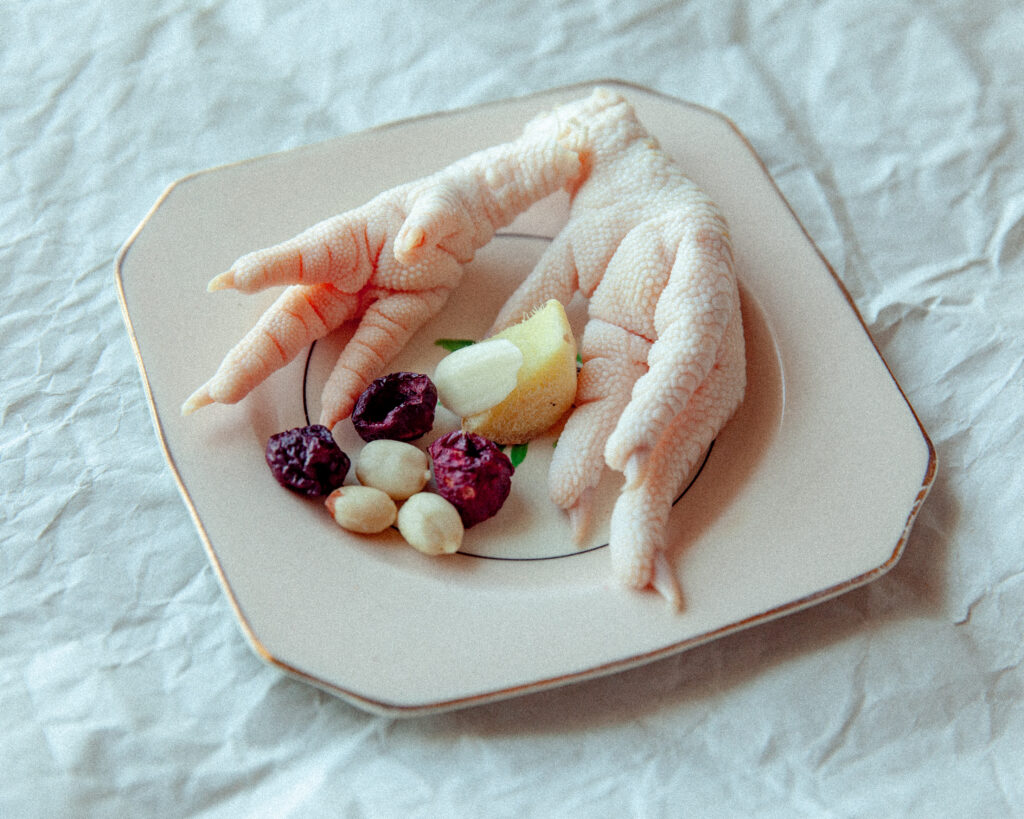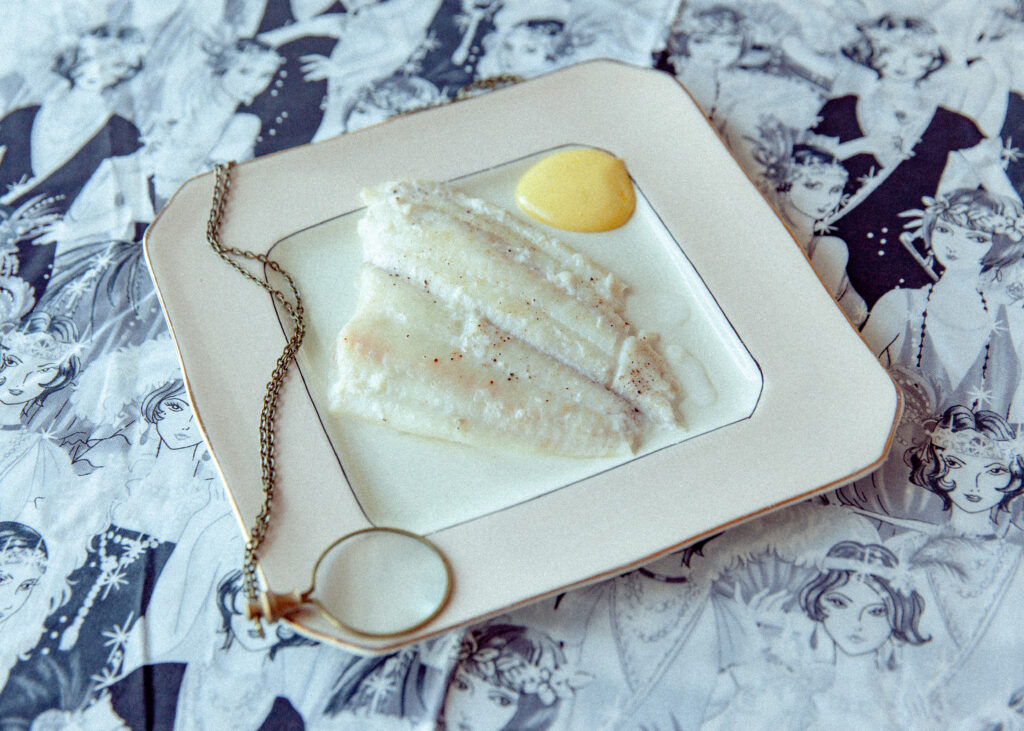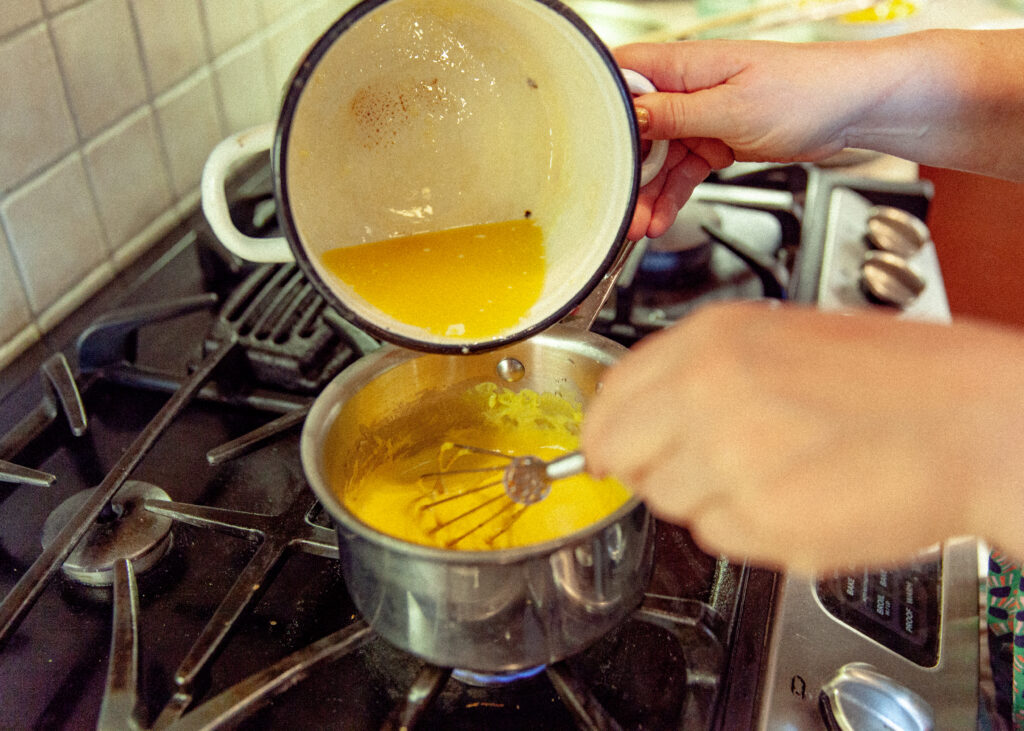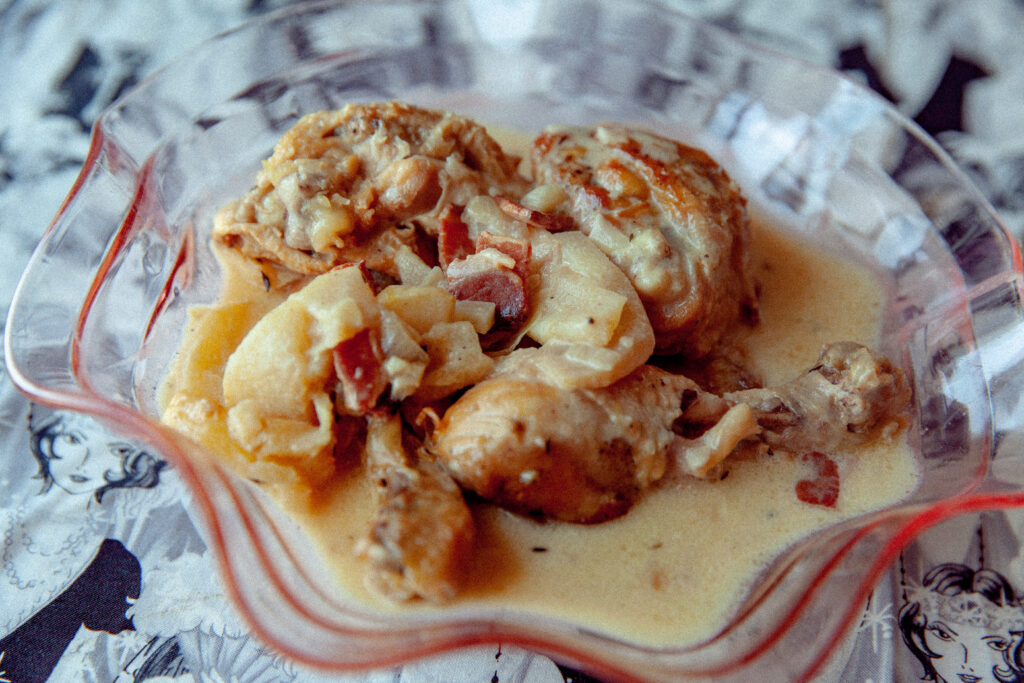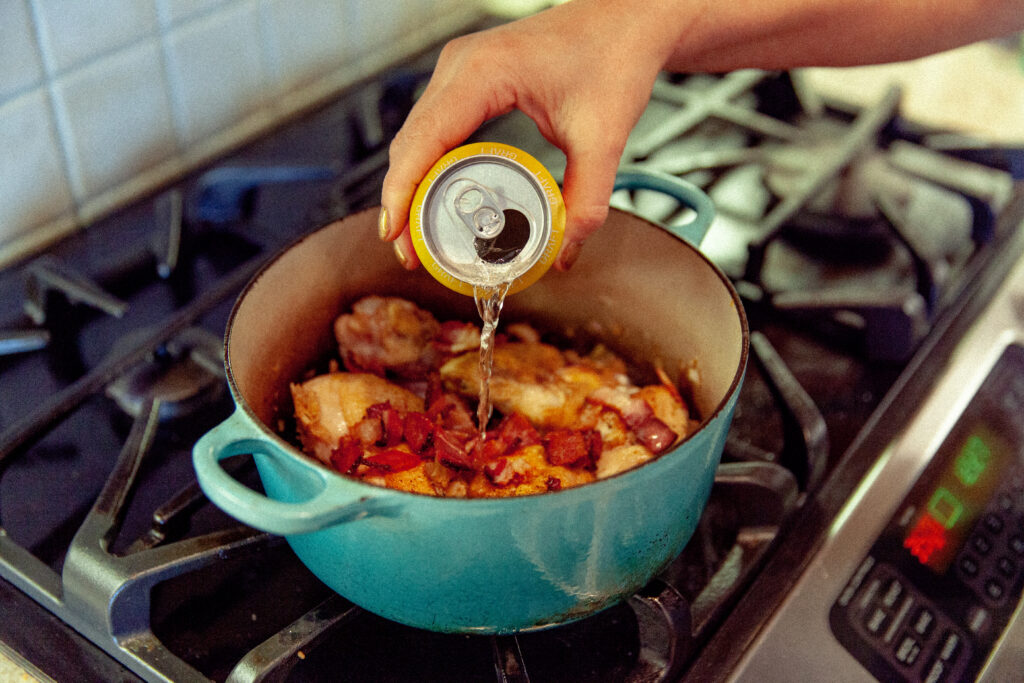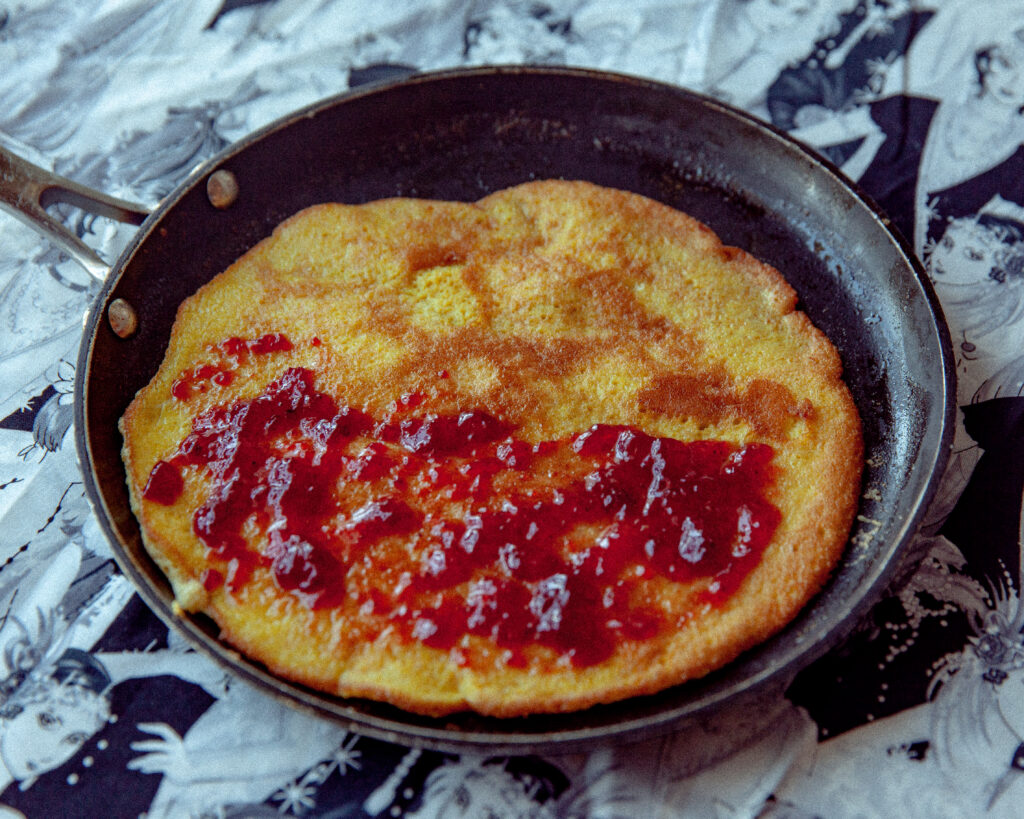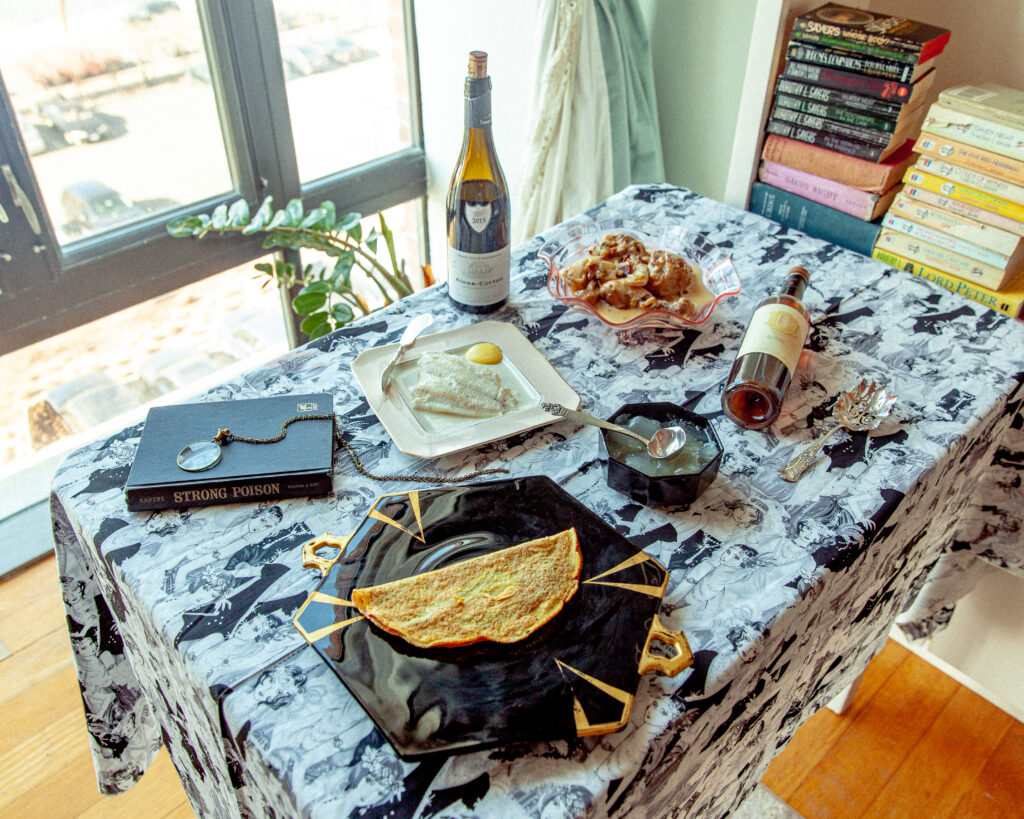Cooking with Dorothy Sayers
Dorothy Sayers’s Strong Poison opens with a description of a man’s last meal before death. The deceased, Philip Boyes, was a writer with “advanced” ideas, dining at the home of his wealthy great-nephew, Norman Urquhart, a lawyer. A judge tells a jury what he ate: the meal starts with a glass of 1847 oloroso “by way of cocktail,” followed by a cup of cold bouillon—“very strong, good soup, set to a clear jelly”—then turbot with sauce, poulet en casserole, and finally a sweet omelet stuffed with jam and prepared tableside. The point of the description is to show that Boyes couldn’t have been poisoned, since every dish was shared, with the exception of a bottle of Burgundy (Corton), which he drank alone. The judge’s oration is another strike against the accused, a bohemian mystery novelist named Harriet Vane, who saw Boyes on the night he died, and had both motive and opportunity to poison him. Looking on from the audience, the famous amateur detective Lord Peter Wimsey writhes in misery; he believes Harriet Vane is innocent, and he has fallen suddenly and completely in love with her.
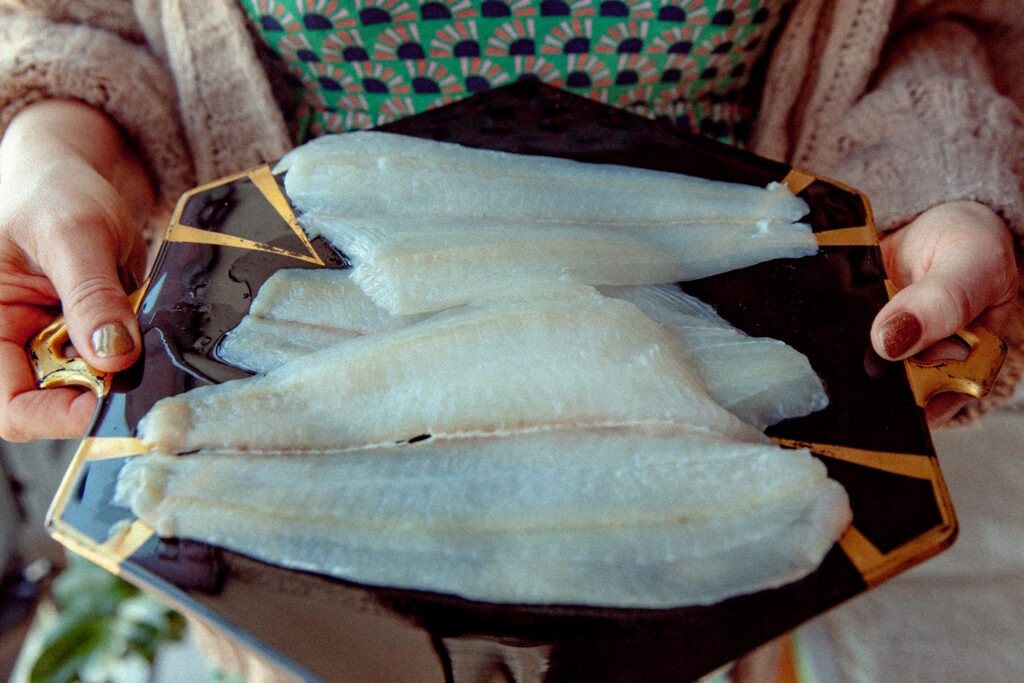
Strong Poison was published in 1930, but the meal at Norman Urquhart’s was rooted in the Victorian era, serving a fish dish prior to a poultry dish. Photograph by Erica Maclean.
The moment is one of great significance for fans of Sayers’s work. The eleven Wimsey books, published between 1923 and 1937, hinge on the romance between Wimsey and Vane, which percolates through several novels following Strong Poison, and culminates in Gaudy Night and Busman’s Honeymoon. For me, though, it’s the menu that’s more intriguing: cold Jell-O soup, followed by sauce-smothered fish, soggy-skinned chicken, and eggs with jam? Even if you account for changing tastes, this meal is a pungent reminder that Dorothy Sayers was having a joke. Urquhart is smugly respectable, and the stuffy and unappetizing menu illustrates his stodgy Victorian-era tastes. Moreover, it reminds us that Wimsey began as a satire—a bumbling Bertie Wooster who detects things—dreamed up a time when Sayers desperately needed the money. The books were potboilers, and the upper-class milieus, four-course dinners, mannered menservants, literary quotations, and aged wines were played for winks and kicks. When Sayers’s financial situation stabilized, she moved on to work she considered more important: writing a series of religious plays, penning original theology, and translating Dante.
And yet, the books have endured, despite their many flaws, and I’ve read and reread the entire run every few years since first discovering them in high school, including the wonderful one about the church bells and the boring one about the artists’ colony in Scotland. The biographer James Brabazon suggests that their true appeal was the pleasure of spending time in Sayers’s company. She was the daughter of a rector, born in Oxford, and a member of its first female graduating class. Her erudition informs her plots, and Peter’s silly, quotation-laden verbal style has delighted readers for generations. When Harriet, declining Peter’s proposal of marriage, tells him that “if anybody ever marries you, it will be for the pleasure of hearing you talk piffle,” the reader understands. Sayers’s books are also credited with being the first feminist detective stories, and she also worked in advertising as a woman in the twenties, wore gender-bending three-piece suits, and expressed a frank sexuality. Brabazon writes that her work has been so successful because it “communicat[es] her energy, her amusement, her intelligence, her love of writing, her enthusiasm, her sense of fun.” I refined that theory when I read—at long last—the work Sayers did take seriously: her theology and her translation of Dante. How I’d never done this before is the true mystery.
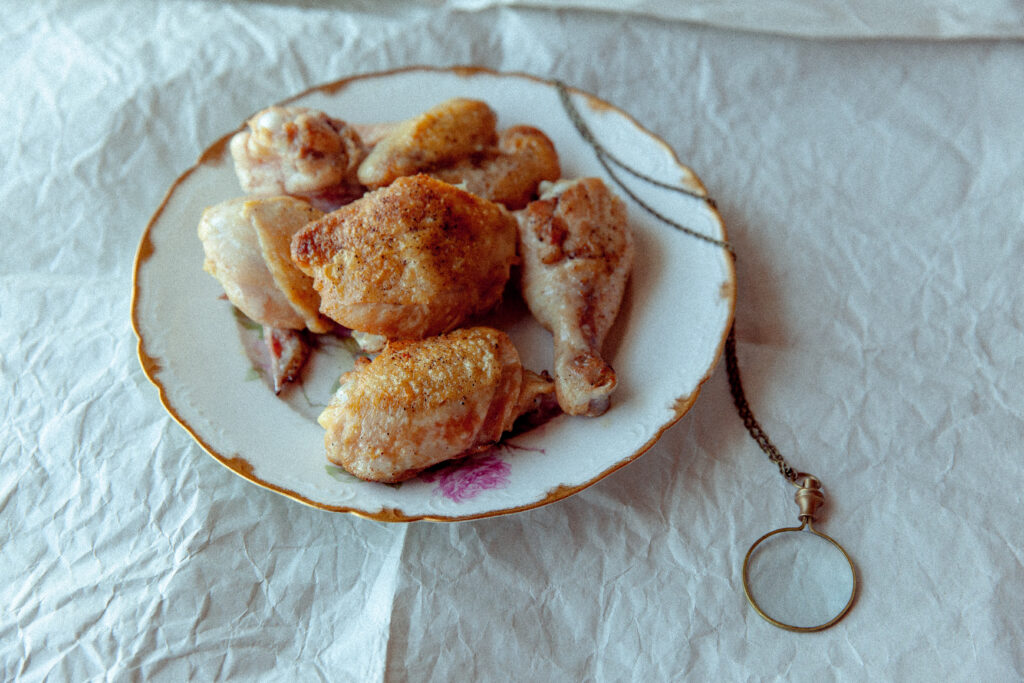
A character calls Sayers’s sleuth “a chattering icicle in an eyeglass,” but Wimsey warms the reader’s heart while investigating this chicken dish in order to free Harriet Vane. Photograph by Erica Maclean.
Sayers’s theological volume The Mind of the Maker examines what we can learn about God the Creator from observing the practice of human creators—artists. I began skeptically, but was delighted by how original the premise was. I also read two volumes of the Dante translation, still in print from Penguin Classics, and was captivated by Sayers’s notes, which make the rings of hell and levels of purgatory morally and spiritually comprehensible to the modern reader. Even more impressive, in a feat few other translators have dared, she preserved Dante’s rhyme scheme. Familiarity with these works brought my conception of Sayers in line with her self-conception: a writer who was primarily a moral philosopher.
This new understanding of her work brought into focus the aspect of the Wimsey books that I believe has been central to my enjoyment of them. After the courtroom scene, Peter bursts into the visiting room at the jail to propose to Harriet, and she turns him down. She does so because he holds all the cards, because he’s saving her life. In this way, beginning with Strong Poison, Sayers interrogates the idea of marriage and partnership, and insists that it should be a union of equals. Harriet cannot marry Peter while she is dependent on him, nor while she in his debt and humiliated by her trial. The couple struggles to attain equal footing for several books, and when they finally unite they have established each partner’s self-respect and answered all the hard questions, about money and children, individuality and work. The thrill of the love affair, for me, lies in the moral philosophy. It may not have been Sayers’s intention to create this effect—by all accounts the characters’ deepening humanity and increasingly sophisticated struggle was an accidental byproduct of the author becoming better at her craft—but it has kept readers engaged with Wimsey for a century.
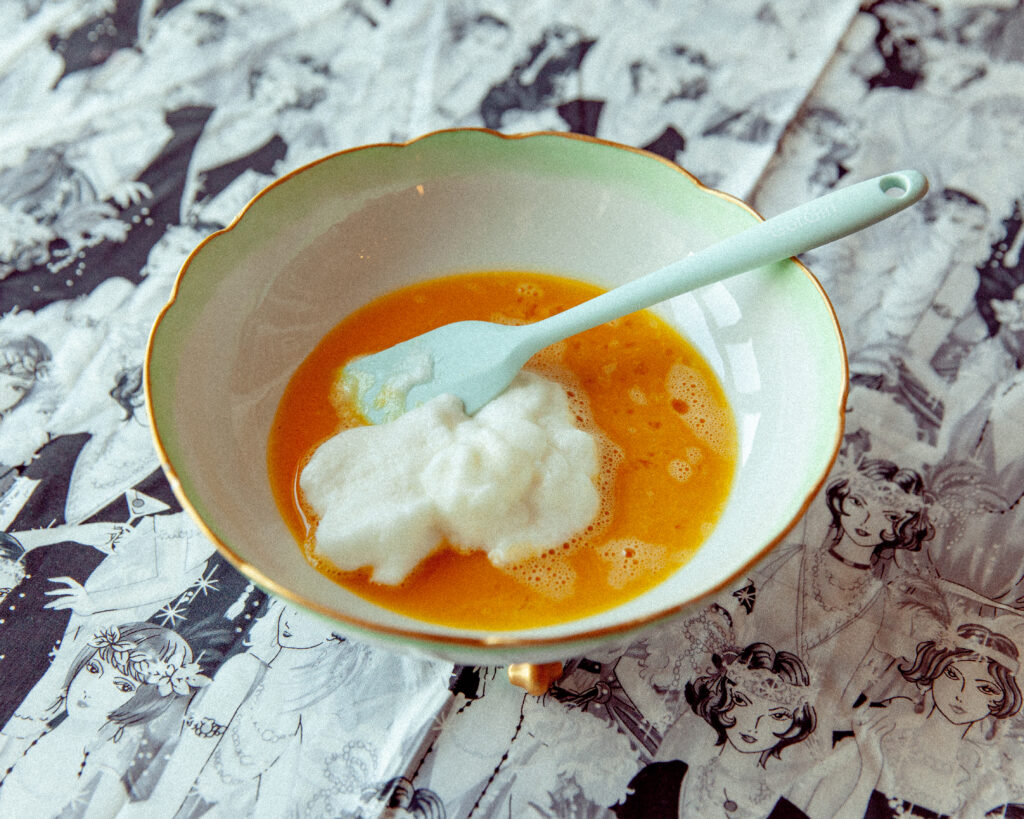
Adding whipped egg whites to a yolk and sugar mixture should produce a light and fluffy sweet omelet. Photograph by Erica Maclean.
Sayers transcended her genre, so I hoped she would also transcend her satirical murder menu and that together we would make a good meal. I set out to make the four-course dinner from Strong Poison, staying true to the letter of the recipes while making adjustments to suit my palate. The soup “set to a clear jelly” sounded like the worst of it, so I made no attempt to season it blandly, as an English cook in the twenties probably would have. Instead I thought of a collagen-rich broth made from a Chinese recipe, with chicken feet infused with the flavor of peanuts and red dates. The fish course in the novel was turbot, a flatfish whose flesh is a delicacy. I bought flounder, which is less expensive, poached it in milk, and served it with hollandaise, following a recipe from Alain Ducasse. This seemed appropriate, since the next course was also French-influenced: a poulet en casserole. The term can refer to any kind of chicken cooked in a pot, with vegetables. I found one à la Normande with bacon and apples, braised in apple cider. It was seasoned with garlic, which would have been considered risqué in twenties England, but I wanted my dish to have lots of flavor. The internet had plentiful recipes for sweet omelets, which are about as simple as they sound (an omelet, just add sugar).
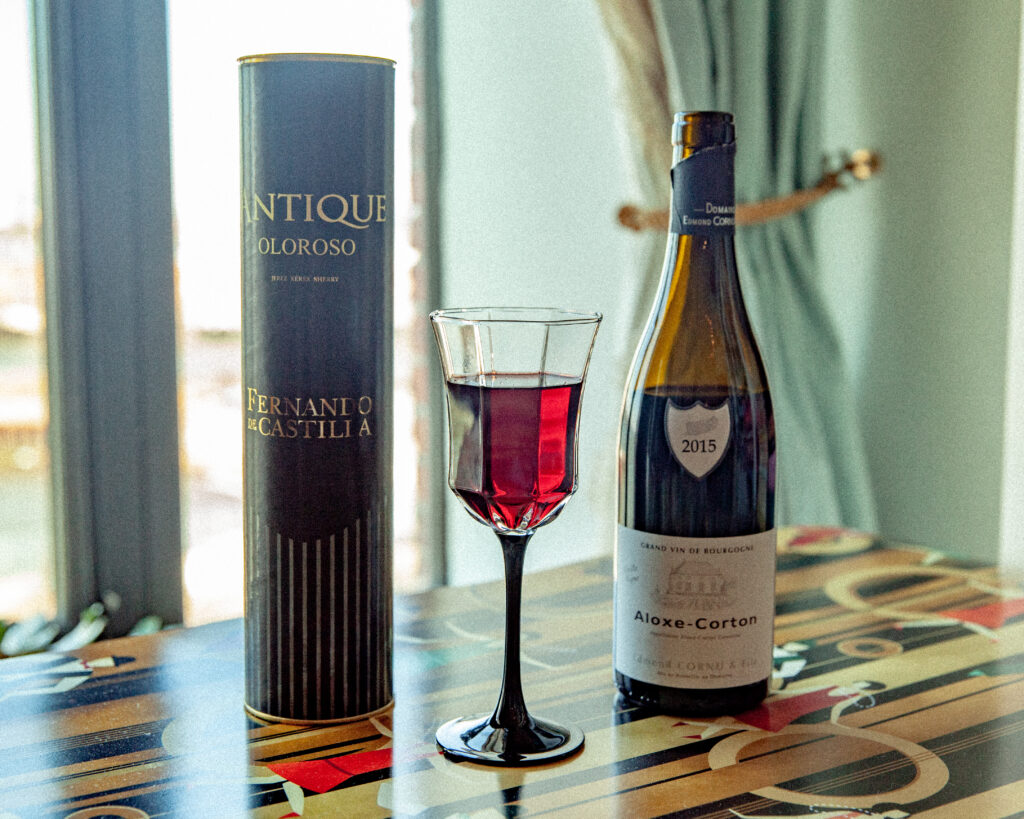
The wine in the book is a Grand Cru, a designation for wines from the most elite subregions. Ours is from Aloxe-Corton, a village adjacent to Corton. Photograph by Erica Maclean.
Dorothy Sayers was said to enjoy both food and drink in great quantities. And her characters do as well. Wimsey is a wine connoisseur, and this was the first time I’d reread the series since becoming interested in wine myself. Even prior to rereading, I recalled several pivotal moments involving wines—a short story in which Wimsey proves his identity against two imposter Wimseys through duel of palates, and the scandal provoked when Mrs. Ruddle washes the bottles of Cockburn ’96 port in Busman’s Honeymoon. Analysis performed with Hank Zona, my spirits consultant, revealed that Sayers was having her fun with wines too. Wimsey’s ports and clarets and brandies and Sauternes and Burgundies were the best of his day, and most are still being made in ours. Some of the specific vintages mentioned are even available today as collectors’ items: a bottle of the Cockburn port from 1896 sold for $734 online as recently as 2018. To buy the wine from Harriet Vane’s honeymoon would have been a true fan moment, but instead I asked Hank to source the elite wines from the meal from Strong Poison—an oloroso sherry and a Corton Burgundy—in versions I could afford. The ones he found are made in traditional styles and have excellent value for their price point. The sherry was especially close to the one from 1847 that kicked off the meal at Norman Urquhart’s. It came from Fernando de Castilla, a sherry house founded in the 1830s, and is made in “antique” style, meaning unblended, longer aged, and more fortified.
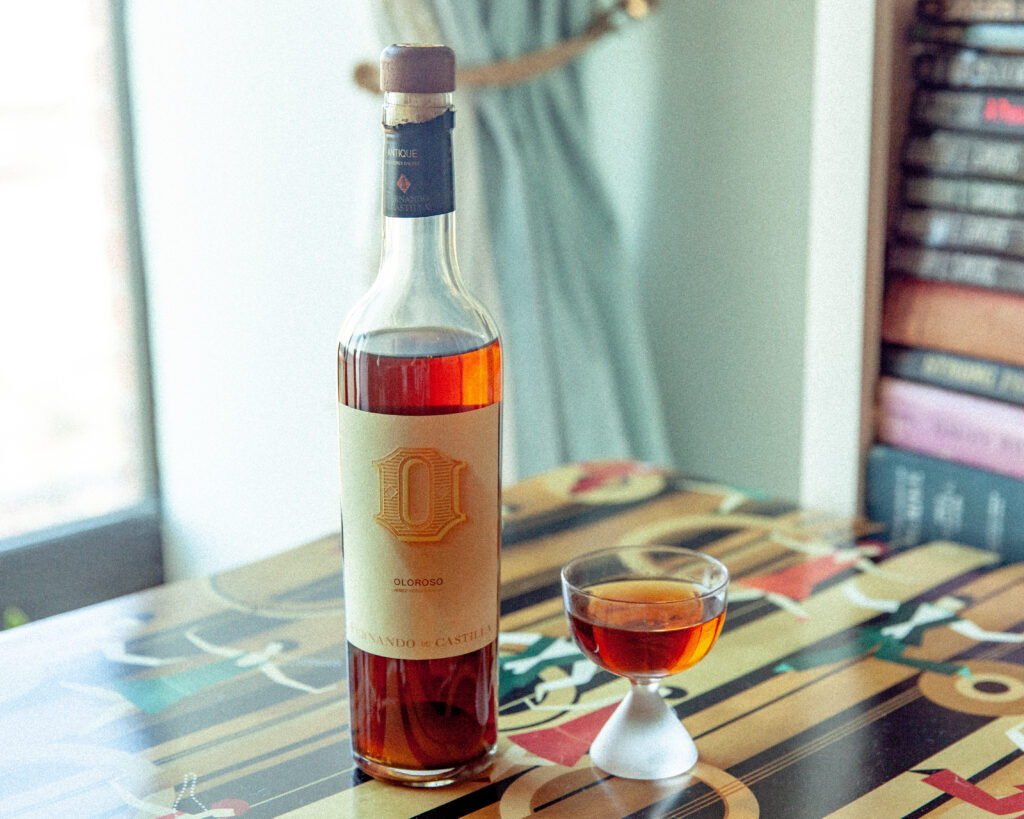
This beautiful oloroso sherry has notes of treacle, warm dates, and powdered ginger. Photograph by Erica Maclean.
But was the meal from Strong Poison poisoned? And if so, how? The plot hangs on this, and I won’t give it away (though there is a little clue here somewhere). I drank my sherry and ate my four protein dishes, as instructed, paired with a red Burgundy. As expected, neither the poisonously sweet omelet dessert nor the jellied soup were to my tastes, but both French recipes were delicious and the meal had a certain old-fashioned elegance. The soup was wonderful when warm; simmering the chicken feet with peanuts and dried fruit made the broth salty, savory, nutty and sweet. For the fish, I loved Alain Ducasse’s suggestion to poach fillets in aromatic-infused milk. The results were so delicate and flavorful they hardly needed the hollandaise sauce. And since my chicken was slow-cooked in hard cider with bacon and cream, it really couldn’t taste bad. I’d recommend only the addition of a crusty baguette to soak up the juices. The omelet for dessert smelled delicious, but was rubbery and flat by the time I ate it, proving the judge’s commentary in the novel that it’s best to prepare an omelet “at the table in a chafing dish” and never allow it to stand or it will get tough. The Burgundy, from Edmond Cornu & Fils in Aloxe-Corton, was the best bottle of wine I’ve tried since I began exploring wine. It had the notes of cherries, raspberries, and earthiness that are characteristic of Pinot Noir, and its bright, lingering presence on my palate reminded me that Sayers considered France and sensuality synonymous. After all, as we find out in Busman’s Honeymoon, Peter Wimsey speaks French in bed—a detail, like all the rest, that is satirical and romantic in just the right measure.
Strong Bouillon
Adapted from a recipe on the Wok & Kim blog.
6 cups water
8 good-quality chicken feet
1 clove garlic, crushed
1 chunk ginger
1 tbsp unsalted peanuts
4 Chinese red dates
1 tsp salt
First, preboil the chicken feet. Place them in a medium saucepan, cover generously with water, and bring to a boil. Turn off the heat and drain. Rinse the pot. Return the feet to the pot, and add the six cups water, garlic, ginger, and salt. Bring to a boil, then turn the heat down to low. Simmer for six hours, adding water as necessary. Turn off the heat and allow the mixture to cool. Strain the broth, discarding the solids. Pour into individual ramekins and chill overnight. Serve cold.
Poached Flounder with Hollandaise Sauce
Adapted from a recipe by Alain Ducasse.
2 fillets of turbot, porgy, or other flatfish, about 1 lb
1 ¼ cups of milk
1 sprig thyme
1 clove garlic
1 bay leaf
salt
2 black peppercorns
pepper
7 oz butter, melted
3 egg yolks
½ lemon
Salt
Bring the milk to a boil in a medium saucepan. Add the thyme, garlic, bay leaf, salt, and peppercorns and simmer for twenty minutes, to allow the aromatics to infuse into the milk. Remove the aromatics with a skimmer, then gently lower the fish into the milk. Cook for ten minutes.
To make the hollandaise sauce, combine the egg yolks with a little bit of water in a small pot over very low heat. Whisk continuously until the mixture is pale yellow and fluffy, and has a ribbonlike consistency when drizzled off the whisk. Slowly whisk in the melted butter, then the lemon juice. Season with salt and pepper to taste.
Poulet en Casserole
Adapted from a recipe on the Vikalinka blog.
1 tbsp olive oil
2 lbs chicken thighs and legs, well seasoned with salt and pepper
4 shallots, diced
1 rib celery, diced
4–5 thyme sprigs
2 cloves garlic, minced
6 strips bacon, chopped
2 tbsp brandy or whiskey
2 tbsp flour
⅓ cup chicken stock
1 ½ cups hard, dry, apple cider
2 apples, cored and cut into wedges
½ cup heavy cream
Preheat the oven to 350°F.
In a large casserole dish, brown the chicken parts in one tablespoon of oil over medium-high heat until golden. Remove and set aside. Reserve the chicken fat. Add the bacon to the dish and fry over medium heat until crisp, then remove and reserve. If the bacon released a lot of fat, discard that as well. To the same pan, add the shallot, celery, and two sprigs of thyme and cook until soft but not colored, for five to seven minutes. Add the garlic and cook thirty seconds longer, while stirring.
Deglaze the pan with some brandy and stir, scraping up any browned bits from the bottom. Add the flour and stir until it’s combined with the fat and turns into a paste, then slowly add the chicken stock and stir until the mixture resembles a thick gravy, then pour in the apple cider and stir to combine. Return the chicken and bacon to the dish, along with three more sprigs of thyme, and bring to a boil.
Cover, place in the preheated oven, and cook for thirty minutes. Uncover and cook for thirty minutes more. While the chicken is in the oven, fry the apple wedges in two tablespoons of the reserved chicken fat. Do not let them burn.
Take the casserole out of the oven, add the heavy cream, and cook for twenty minutes more. Taste and adjust seasonings for salt and pepper. Stir in the fried apple wedges just before serving.
Sweet Omelet with Jam
2 eggs
2 teaspoons sugar
½ tsp vanilla
2 tsp butter
Jam to serve
Separate one of the eggs and whisk the white until it holds soft peaks. In another bowl, whisk together the sugar, vanilla, remaining egg, and remaining egg yolk. Gently fold in the whisked white.
Melt the butter in a nonstick skillet over medium heat. Add the egg mixture and fry until set on the bottom and firm enough to hold its shape. Flip and finish cooking. Spread the jam on one half of the omelet, fold over, and serve immediately.
Valerie Stivers is a writer based in New York. Read earlier installments of Eat Your Words.
Copyright
© The Paris Review


